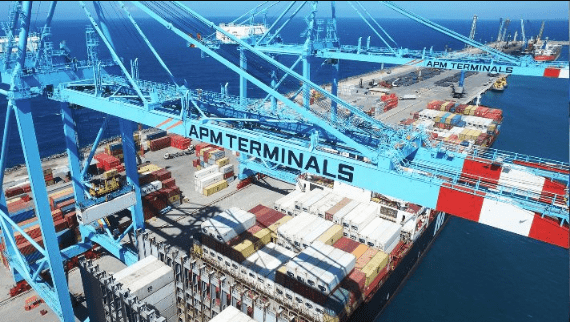APM Terminals has been named the winner of the 2015 Lloyd’s List Global Awards “Port Operator Award” in recognition of establishing new industry standards in the areas of productivity, investment in underserved markets, multiports, safety, inland services and innovation. The company is constantly growing and operates 65 ports, including APM Terminals Maasvlakte II. The fully-automated, wind-generated electricity-powered terminal is the world’s most technologically advanced and environmentally sustainable terminal, designed to handle ultra-large containerships safely and efficiently.
“We are very proud of what we have been able to accomplish as a team effort of more than 20,000 people and grateful for this recognition by the judges” said APM Terminals CEO Kim Fejfer.
The transition of the global container fleet to an increasing dependency on vessels of 10,000 TEU capacity and above has introduced challenges to the port and terminal operating industry. These are reflected in both demand for greater terminal productivity and the need for increased accident risk awareness with larger volumes of container movements required for each vessel call. APM Terminals in 2014 demonstrated industry leadership in both key areas, dominating the JOC Group’s annual terminal productivity study, as well as reducing the Lost-Time Incident Frequency (LTIF) rate throughout the APM Terminals port and Inland Services operations by 22% over the year prior.
The JOC Group study cited 13 facilities within the APM Terminals Global Terminal Network as among the world’s productivity leaders for the first half of 2014, as measured by crane moves per hour (MPH) with a vessel alongside, with APM Terminals Yokohama once again the world’s productivity leader at 180 MPH. In addition to holding the top spot globally (and concurrently in Asia), APM Terminals Rotterdam ranked first in productivity among European Terminals, with 102 MPH, and APM Terminals Port Elizabeth, at the Port of New York and New Jersey led all US terminals with 82 MPH during the first six months of 2014, within the award entry qualifying period.
In terms of Safety Performance, the combined LTIF rate for APM Terminals’ port and inland services operations fell to 1.41 per million man-hours worked in 2014 from 1.81 in 2013; this is the eighth consecutive annual decline in the LTIF rate for the APM Terminals port and Inland Services portfolio.
On the local level, APM Terminals Pier 400 Los Angeles, the world’s largest propriety container terminal, in North America’s busiest container port, won two awards at the 66th Annual Pacific Maritime Association Area Accident Prevention Committee Safety Awards in March 2015. The first award was for the best Safety Performance in 2014 of all operations at US West Coast ports. APM Terminals Pier 400 also won the Southern California Area Container Terminal Safety Award, while handling 2.19 million TEUs for the year. Elsewhere, APM Terminals Apapa, which operates the busiest container terminal in West Africa, with 700,000 TEUs handled in 2014, was named the “Most Environmentally Conscious Port Operator at the Lagos Port Complex” by the Nigerian Port Authority’s Environment Department of the Health, Safety and Environment Division.
APM Terminals also continued to invest in emerging markets underserved by modern infrastructure, where industry-leading standards of safety and productivity have an even greater impact. In May 2014, APM Terminals signed a 20 year concession to operate, maintain and develop the Port of Namibe, Angola. In June 2015, the company signed an agreement with the Government of Ghana, for a $1.5 billion expansion of Tema Port, including the construction of new port access roads.
“Leadership in innovation, safety, productivity and new investment, however, are not new goals or results for APM Terminals”, noted Mr. Fejfer, as the company was also named “Port Operator of the Year” at the Lloyd’s List Global Awards in 2012.
